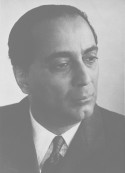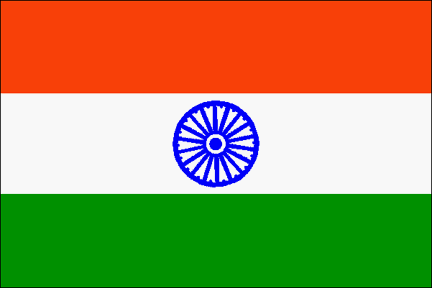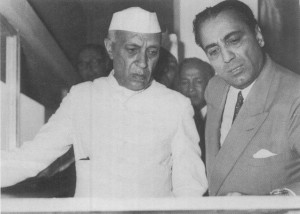
250x346, 12 K





Full credit for the establishment of India's nuclear research program, and its nuclear weapons program, must be given to Dr. Homi Jehangir Bhabha, a man who throughout his life dominated both the scientific and policy spheres of India's nuclear affairs, first bringing the Indian nuclear program to life and then setting its priorities and direction.
 250x346, 12 K | |
| Homi Jehangir Bhabha | |
| Bigger image (347x480, 20 K) | |
| Biggest image (603x835, 66 K) |
Bhabha was born in 1909, of a wealthy well connected Parsi family. Bhabha's uncle was Sir Dorab Tata (married to Bhabha's father's sister), son of the founder of the powerful Tata group. Bhabha grew up in Mumbai (formerly Bombay) while his father was inspector general of education in Mysore.
In 1927, at age 18, Bhabha sailed to England to study engineering at Cambridge. He soon decided that his true interest was in nuclear physics, a field then flowering with Cambridge as one of its centers. Bhabha received a Ph.D. in physics from Cambridge University in 1935, studying the physics of cosmic rays. While in Europe he met many of the greatest physicists of the day, who would later play major roles in the US-UK wartime atomic weapon programs -- among them Niels Bohr, James Franck, and Enrico Fermi. Bhabha was well respected within the international physics community, and has left his name associated with the phenomenon of Bhabha electron scattering. One of Bhabha's friendships at Cambridge would later play a prominent role in the development of India's nuclear program - his friendship with his rowing teammate W.B. Lewis, later chairman of the Canadian Energy Programme.
Bhabha learned of the discovery of fission while abroad. He returned to India in 1939, taking the post of Reader in Theoretical Physics at the Indian Institute of Science (IISc) in Bangalore under Nobel laureate Sir C.V. Raman.
Bhabha showed an immediate visionary interest in nuclear technology, apparently independently detecting the existence of the Manhattan Project during the war by noticing the absence of publications from the leading physicists with which he was acquainted. In March 1944, even before the successful achievement of a chain reaction became publicly known, Bhabha wrote a proposal to the Tata Trust that led to the establishment of an institute for nuclear research in India. This institute, the Tata Institute of Fundamental Research (TIFR) named for Bhabha's uncle, was created on 19 December 1945 in Mumbai with Dr. Bhabha as its Director. And so from the very outset, only four months after Hiroshima and years before India became an independent nation, Bhabha was already in command of India's nuclear future. And so he remained until the moment of his death over 20 years later.
Bhabha was acquainted with India's first Prime Minister Jawarhalal Pandit Nehru, having met him on the voyage home in 1939. After Nehru became the new nation's first leader Bhabha was entrusted with complete authority over all nuclear related affairs and programs and answered only to Nehru himself, with whom he developed a close personal relationship. All Indian nuclear policy was set by unwritten personal understandings between Nehru and Bhabha.
From the outset Bhabha's plans for India where extraordinarily ambitious. In April 1948 Nehru agreed to legislate at Bhabha's request the Atomic Energy Act in the Constituent Assembly, creating the Indian Atomic Energy Commission (IAEC).
On 3 January 1954 the IAEC decided to set up a new facility - the Atomic Energy Establishment, Trombay (AEET), later to become the "Indian Los Alamos". On 3 August 1954 the Department of Atomic Energy (DAE) was created with Dr. Bhabha as Secretary. This department answered directly to the Prime Minister and has continued to do so down to the present day.
Bhabha personally recruited and sponsored many of the principal players in the successful efforts to develop and test nuclear weapons such as Homi Sethna, P.K. Iyengar (hired 1952), Vasudev Iya, and Raja Ramanna -- hired by Bhabha in 1949 and given a J.N. Tata scholarship at King's College in London.
Ramanna confirms that Bhabha planned from the very outset to establish an Indian nuclear weapons capability. Bhabha told Ramanna during that period that
"We must have the capability. We should first prove ourselves and then talk of Gandhi, non-violence and a world without nuclear weapons."[Chengappa 2000; pg. 82].
Although Nehru founded the non-aligned movement, and generally promoted disarmament efforts, his biographer S. Gopal stated in 1997 that Nehru actually opposed complete abolition of nuclear weapons [Chengappa 2000, pg. 83], and supported Bhabha's plans for developing an Indian nuclear weapons option.
In 1955 Bhabha's personal relationsip with Lewis was instrumental in the program to build Cirus, the Canadian heavy water reactor - ostensibly for peaceful research but desired by India for its potential as an ideal system for producing weapons grade plutonium, a capability later exploited.
The power that Bhabha held is no where more sharply illustrated by the fact that in the wake of China's first nuclear test PM Lal Bahadur Shastri, Nehru's successor, found it necessary to align his policies with the preferences of Dr. Bhabha, and secure his personal endorsement to withstand legislative and public criticism.
 640x456, 42 K |
Bhabha (right) and Nehru (left) together |